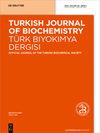念珠菌利用农工副产品NRRL-Y-900生产胞外脂肪酶
IF 0.7
4区 生物学
Q4 BIOCHEMISTRY & MOLECULAR BIOLOGY
Turkish Journal of Biochemistry-turk Biyokimya Dergisi
Pub Date : 2014-01-01
DOI:10.5505/TJB.2014.96977
引用次数: 4
摘要
目的:筛选各种酵母培养物和农工副产物,优化固态发酵技术下微生物生产胞外脂肪酶的发酵条件。材料与方法:采用250ml Erlenmeyer瓶固体发酵间歇式培养的方法,对多脂假丝酵母NRRL-Y-1095、实用假丝酵母NRRL-Y-900、热带假丝酵母NRRL-Y-1552、酿酒酵母iib1等多种酵母培养物进行筛选。培养基中补充了各种氮源(有机和无机)和金属离子。结果:利用念珠菌NRRL-Y-900对豆粕产酶量最高。并对底物和润湿剂的粒径进行了优化,使脂肪酶的合成达到最大。利用念珠菌NRRL-Y-900积累酶的最适温度和pH分别为30℃和6.5℃。发酵时间为60h,接种量为7.5%,发酵24h时产酶量最大。最佳培养基组成为2% (w/v)肉精、0.4% (w/v)硫酸铵和5mM Fe+2。结论:本研究结果具有重要意义,首次报道了C. utilis NRRL-Y-900在优化条件和固态发酵条件下利用豆粕积累脂肪酶的研究。本文章由计算机程序翻译,如有差异,请以英文原文为准。
Production of an extracellular lipase by Candida utilis NRRL-Y-900 using agro-industrial by-products
Aim:To screen various yeast cultures and agro-industrial by-products and optimization of fermentation conditions for the microbial production of extracellular lipase under solid state fermentation technique. Material and Methods: Various yeast cultures including Candida lipolytica NRRL-Y-1095, Candida utilis NRRL-Y-900, Candida tropicalis NRRL-Y-1552, Saccharomyces cerevisiae IIB-1 were screened by culturing on agro-industrial by-products under batch culture using solid state fermentation in 250 mL Erlenmeyer flasks. The medium was supplemented with various nitrogen sources (both organic and inorganic) and metal ions. Results: Candida utilis NRRL-Y-900 showed the highest enzyme production on soybean meal. Various particle sizes of substrate and moistening agents were also optimized for the maximum lipase synthesis. The optimum temperature and pH for the accumulation of enz- yme by Candida utilis NRRL-Y-900 was 30oC and 6.5, respectively. The fermentation time of 60h was suitable for the maximum enzyme production by using 7.5% inoculum of 24h old yeast culture. The optimal medium composition consisted of 2% (w/v) meat extract, 0.4% (w/v) ammonium sulphate and 5mM Fe+2. The maximum extracellular lipase production was 3.96±0.09 U. Conclusion: The results obtained during the study are significant for, to our knowledge, it is the first report regarding the utilization of soybean meal by C. utilis NRRL-Y-900 to accu- mulate lipase under optimized conditions and solid state fermentation.
求助全文
通过发布文献求助,成功后即可免费获取论文全文。
去求助
来源期刊
CiteScore
1.20
自引率
0.00%
发文量
0
审稿时长
6-12 weeks
期刊介绍:
Turkish Journal of Biochemistry (TJB), official journal of Turkish Biochemical Society, is issued electronically every 2 months. The main aim of the journal is to support the research and publishing culture by ensuring that every published manuscript has an added value and thus providing international acceptance of the “readability” of the manuscripts published in the journal.

 求助内容:
求助内容: 应助结果提醒方式:
应助结果提醒方式:


